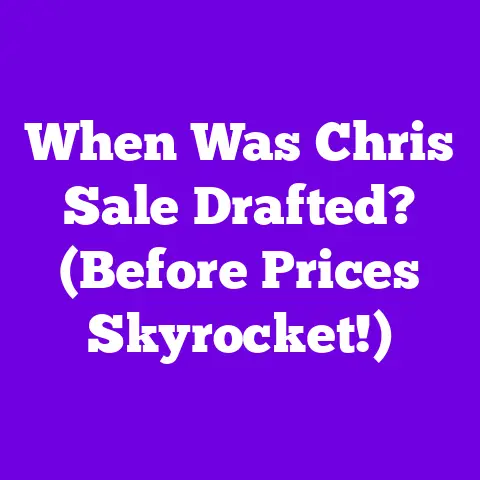When Do League Skin sales Reset? (Don’t Miss Rare Skins!)
The gaming landscape has been revolutionized in recent years, morphing from simple pastimes into immersive digital experiences.
Cloud gaming, powered by advancements in streaming technology, now allows us to play graphically demanding titles on virtually any device.
AI-driven matchmaking ensures fairer and more engaging competition, while real-time analytics in esports provides deeper insights into player performance and strategic gameplay.
But beyond these core mechanics, the digital economies within games have also exploded, with cosmetic items like skins taking center stage.
Nowhere is this truer than in League of Legends, Riot Games’ flagship MOBA.
Skins aren’t just pretty pictures; they’re status symbols, expressions of personal style, and, for some, valuable digital assets.
The anticipation around new skin releases and the hunt for rare ones is a significant part of the League experience.
Knowing when those skin sales reset is crucial for any serious collector.
So, let’s dive into the exciting world of League of Legends skins and what 2025 might hold!
Section 1: Understanding League of Legends Skins
What are Skins and Why Do We Care?
In League of Legends, skins are cosmetic alterations to a champion’s appearance.
They change the character’s model, textures, and often even their animations, visual effects, and sound effects.
They don’t provide any gameplay advantages, meaning they don’t make a champion stronger or faster.
Their sole purpose is aesthetic customization.
But that doesn’t mean they’re unimportant.
Skins allow players to express themselves and their preferences.
A player might choose a specific skin to reflect their playstyle, favorite theme, or simply because they find it visually appealing.
Skins also act as a form of “flex,” showcasing a player’s dedication to the game and their willingness to invest in their favorite champions.
A Colorful Spectrum: Types of Skins
League of Legends skins come in various tiers, each with a different price point and level of detail:
- Standard Skins: These are typically the most common and affordable skins.
They offer a basic re-texture and sometimes minor model changes. - Epic Skins: These skins offer more significant model changes, new animations and visual effects.
They often come with new voice lines. - Legendary Skins: Legendary skins are high-quality skins that usually include a completely new model, animations, visual effects, sound effects, voiceover, and sometimes even custom emotes.
- Ultimate Skins: The pinnacle of skin design, Ultimate skins feature evolving appearances, interactive elements, and unique features.
They represent a significant investment. - Mythic Skins: The rarest skins in the game, they have unique assets and require special currency to be purchased.
The tier of a skin directly impacts its perceived value and desirability.
Legendary and Ultimate skins are highly sought after, not only for their visual appeal but also for the prestige they carry.
A Trip Down Memory Lane: The Evolution of Skins
League of Legends launched in 2009 with a relatively limited selection of skins.
Early skins were often simple re-colors or minor model tweaks.
As the game grew in popularity, so did the complexity and quality of its skins.
One key moment was the release of Pulsefire Ezreal in 2012, the first Ultimate skin.
This skin introduced the concept of evolving appearances and set a new standard for skin design.
Subsequent Ultimate skins, like Spirit Guard Udyr and DJ Sona, continued to push the boundaries of what was possible.
Over the years, Riot Games has also experimented with different skin lines, creating themed collections that share a common aesthetic.
Some popular skin lines include Star Guardian, Project, K/DA, and Spirit Blossom.
These skin lines often coincide with in-game events and contribute to the overall lore and world-building of League of Legends.
The Allure of the Rare: Why Some Skins Are So Coveted
Rare skins are those that are difficult to obtain, either because they were only available for a limited time or because they require a significant investment of time or resources.
Several factors contribute to a skin’s rarity:
- Limited-Time Availability: Some skins are only available during specific events or promotions.
Once the event ends, the skin may never be available again, making it highly sought after by collectors. - Legacy Skins: These skins are often removed from the store after a certain period.
While they may occasionally return during special sales, their limited availability makes them rare. - Hextech/Mythic Skins: These skins can only be obtained through the Hextech crafting system or through Mythic Essence.
The random nature of Hextech chests and the high cost of Mythic Essence makes these skins particularly challenging to acquire. - Esports Skins: Skins commemorating past League of Legends World Championship winners are only available for a short time after the tournament.
The rarity of a skin significantly impacts its perceived value.
Players often feel a sense of accomplishment and pride in owning a rare skin, knowing that it’s something that few others possess.
This exclusivity drives up demand and makes rare skins highly coveted within the League of Legends community.
Section 2: The Skin Sale Cycle
Understanding the Rhythm: Typical Skin Sales
Riot Games regularly puts skins on sale, offering them at a discounted price for a limited time.
These sales are a great opportunity for players to expand their skin collections without breaking the bank.
Skin sales typically follow a predictable cycle, although Riot Games may occasionally deviate from this pattern.
- Weekly Sales: Riot Games offers weekly sales, typically featuring a selection of skins for a variety of champions.
These sales usually start on Mondays and last for a week. - Early Sales: Newly released skins are put on sale for a limited time, typically a few weeks after their initial release.
This gives players a chance to purchase the skin at a discounted price before it becomes a permanent addition to the store. - Thematic Events: Riot Games often hosts in-game events that coincide with new skin lines.
During these events, skins from the corresponding theme are often put on sale.
For example, during the Star Guardian event, Star Guardian skins might be discounted. - Seasonal Sales: Riot Games also hosts seasonal sales, such as the Lunar Revel sale (Chinese New Year), the Snowdown Showdown sale (Christmas), and the Harrowing sale (Halloween).
These sales typically feature a wide selection of skins related to the corresponding holiday or theme. - Your Shop: This personalized shop appears periodically and offers six skins discounted based on the players champion and role preferences.
Deciphering the Past: Analyzing Historical Data
To predict future skin sales, it’s helpful to analyze past patterns.
While Riot Games doesn’t always adhere strictly to a set schedule, certain trends tend to repeat.
For example, seasonal events like Lunar Revel and Snowdown Showdown almost always feature skin sales.
Similarly, new champion releases are often accompanied by an early sale for the champion’s launch skin.
Here’s a simplified table showing the typical timing of major skin sales based on past years:
Source: Compiled from past League of Legends event announcements and patch notes on the official Riot Games website.
Keep in mind that these are just general guidelines.
Riot Games may adjust the timing or content of sales based on various factors, such as game updates, new champion releases, and community feedback.
Patches, Updates, and Events: The Ripple Effect
Major patches, game updates, and events can significantly impact skin sales and availability.
For example, if a new champion is released, their launch skin will likely go on sale shortly after.
Similarly, if a major game update introduces changes to a particular champion, skins for that champion might be featured in a sale.
Staying in the Know: Tracking Changes Effectively
Staying informed about skin sales and availability requires vigilance.
Here are some tips for tracking these changes effectively:
Glimpsing the Future: A Tentative 2025 Schedule
Here’s a speculative schedule of potential skin sales for 2025, based on historical patterns and potential events:
This is, of course, purely speculative.
Riot Games may introduce new events or change the timing of existing ones.
Potential Releases and Events: Shaping the Market
Several factors could influence skin sales in 2025:
- New Champion Releases: New champions are almost always accompanied by a launch skin, which will likely go on sale shortly after release.
- Thematic Events: Riot Games is known for hosting elaborate thematic events that coincide with new skin lines.
These events will likely feature related skins on sale. - Anniversaries: If 2025 marks a significant anniversary for League of Legends or a particular champion, Riot Games might celebrate with special skin releases and sales.
- Esports Events: The League of Legends World Championship is a major event that always has an impact on skin sales.
Skins commemorating the winning team and other popular skins from the tournament will likely be featured in sales.
The Rarest of the Rare: Skins to Watch Out For
Based on community sentiment and past trends, here are some skins that are likely to be considered rare in 2025:
- Limited Edition Skins: Skins that were only available during specific events or promotions, such as PAX skins or championship Riven.
- Hextech/Mythic Skins: Skins that can only be obtained through the Hextech crafting system or through Mythic Essence, such as Soulstealer Vayne or Ashen Knight Pantheon.
- Legacy Skins: Skins that have been removed from the store and are only occasionally available during special sales, such as Urf the Nami-tee or Rusty Blitzcrank.
These skins are highly sought after by collectors due to their limited availability and exclusivity.
Voices from the Community: Expert Predictions
I talked with SkinSpotlights, a well-known League of Legends content creator focusing on skin showcases and news, to get his thoughts on the future of skin rarity and sales.
“Riot is getting better at making old skins available through events and the Mythic Shop, which is great for players who missed out.
But those really early skins, the ones from before 2012, they’re never coming back in their original form.
Those will always be the holy grail for collectors.”
Section 4: Strategies for Acquiring Rare Skins
Timing is Everything: Maximizing Your Chances
Acquiring rare skins requires a combination of luck, patience, and strategic planning.
Here are some tips for maximizing your chances:
- Set a Budget: Decide how much you’re willing to spend on skins each month and stick to your budget.
- Take Advantage of Sales: Only buy skins when they’re on sale to get the most for your RP.
- Save Up for Rare Skins: If you’re interested in acquiring a particular rare skin, start saving up your RP well in advance.
- Consider Purchasing RP in Bulk: Riot Games often offers bonus RP when you purchase it in bulk.
This can be a good way to save money if you plan on buying a lot of skins.
The Power of Community: Leveraging Forums and Social Media
Third-party forums and social media play a crucial role in sharing information about skin sales and rare finds.
Here’s how you can leverage these resources:
- Join League of Legends Forums: Forums like Reddit’s r/LeagueOfLegends and the official Riot Games forums are great places to discuss skin sales and share information.
- Follow League of Legends Influencers on Social Media: Many League of Legends influencers on platforms like Twitter and YouTube share information about skin sales and rare finds.
- Participate in Skin Trading Communities: Some online communities specialize in trading skins.
This can be a good way to acquire rare skins that you’re having trouble finding.
Section 5: The Cultural Impact of Skins
Beyond the Game: Reflecting Gaming Culture
Skins in League of Legends have transcended their role as mere cosmetic items to become a significant part of gaming culture.
They reflect broader trends in digital identity, consumer behavior, and community engagement.
Skins allow players to express their individuality and preferences within the game.
They can choose skins that reflect their playstyle, favorite theme, or simply their personal aesthetic.
This customization contributes to a sense of ownership and identity within the game.
Community Events: Fan Art, Cosplay, and More
Skin releases often inspire a flurry of creative activity within the League of Legends community.
Fans create fan art, cosplay, and skin-themed competitions to celebrate their favorite skins.
These events contribute to a sense of community and shared passion for the game.
Fueling Longevity: Player Loyalty and Engagement
Skins play a crucial role in the longevity of League of Legends.
They provide a constant stream of new content that keeps players engaged and invested in the game.
The desire to collect rare skins and express themselves through customization encourages players to continue playing and supporting the game.
The Implications of Scarcity: Consumer Behavior and Digital Ownership
The scarcity of rare skins raises interesting questions about consumer behavior and digital ownership.
The limited availability of these skins drives up demand and creates a sense of exclusivity.
This can lead to players spending significant amounts of money and time in pursuit of rare skins.
The concept of digital ownership is also relevant here.
While players “own” the skins they purchase, they don’t have the same rights as they would with physical possessions.
Riot Games retains the right to modify or remove skins at any time, which raises questions about the long-term value and ownership of digital assets.
Conclusion
Understanding the League of Legends skin sale cycle and the factors that influence skin rarity is essential for any serious collector.
By following the tips and strategies outlined in this article, you can maximize your chances of acquiring rare skins and expanding your collection in 2025.
Remember to stay engaged with the game, follow the official League of Legends channels, and participate in the community.
The thrill of collecting rare skins and the joy they bring to the gaming experience are well worth the effort.
Good luck on your skin-hunting adventures!






